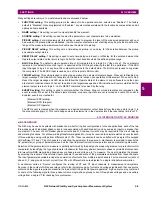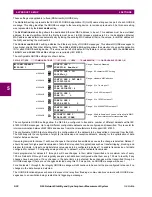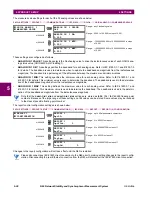
5-18
N60 Network Stability and Synchrophasor Measurement System
GE Multilin
5.2 PRODUCT SETUP
5 SETTINGS
5
PATH: SETTINGS
Ö
PRODUCT SETUP
ÖØ
COMMUNICATIONS
ÖØ
DNP PROTOCOL
Ö
DNP NETWORK CLIENT ADDRESSES
The
DNP UNSOL RESPONSE FUNCTION
should be “Disabled” for RS485 applications since there is no collision avoidance
mechanism. The
DNP UNSOL RESPONSE TIMEOUT
sets the time the N60 waits for a DNP master to confirm an unsolicited
response. The
DNP UNSOL RESPONSE MAX RETRIES
setting determines the number of times the N60 retransmits an unsolic-
ited response without receiving confirmation from the master; a value of “255” allows infinite re-tries. The
DNP UNSOL
RESPONSE DEST ADDRESS
is the DNP address to which all unsolicited responses are sent. The IP address to which unsolic-
ited responses are sent is determined by the N60 from the current TCP connection or the most recent UDP message.
The DNP scale factor settings are numbers used to scale analog input point values. These settings group the N60 analog
input data into the following types: current, voltage, power, energy, power factor, and other. Each setting represents the
scale factor for all analog input points of that type. For example, if the
DNP VOLTAGE SCALE FACTOR
setting is set to “1000”,
all DNP analog input points that are voltages will be returned with values 1000 times smaller (for example, a value of 72000
V on the N60 will be returned as 72). These settings are useful when analog input values must be adjusted to fit within cer-
tain ranges in DNP masters. Note that a scale factor of 0.1 is equivalent to a multiplier of 10 (that is, the value will be 10
times larger).
The
DNP DEFAULT DEADBAND
settings determine when to trigger unsolicited responses containing analog input data. These
settings group the N60 analog input data into the following types: current, voltage, power, energy, power factor, and other.
Each setting represents the default deadband value for all analog input points of that type. For example, to trigger unsolic-
ited responses from the N60 when any current values change by 15 A, the
DNP CURRENT DEFAULT DEADBAND
setting
should be set to “15”. Note that these settings are the deadband default values. DNP object 34 points can be used to
change deadband values, from the default, for each individual DNP analog input point. Whenever power is removed and
re-applied to the N60, the default deadbands will be in effect.
The
DNP TIME SYNC IIN PERIOD
setting determines how often the Need Time Internal Indication (IIN) bit is set by the N60.
Changing this time allows the DNP master to send time synchronization commands more or less often, as required.
The
DNP MESSAGE FRAGMENT SIZE
setting determines the size, in bytes, at which message fragmentation occurs. Large
fragment sizes allow for more efficient throughput; smaller fragment sizes cause more application layer confirmations to be
necessary which can provide for more robust data transfer over noisy communication channels.
When the DNP data points (analog inputs and/or binary inputs) are configured for Ethernet-enabled relays,
check the “DNP Points Lists” N60 web page to view the points lists. This page can be viewed with a web
browser by entering the N60 IP address to access the N60 “Main Menu”, then by selecting the “Device
Information Menu” > “DNP Points Lists” menu item.
The
DNP OBJECT 1 DEFAULT VARIATION
to
DNP OBJECT 32 DEFAULT VARIATION
settings allow the user to select the DNP
default variation number for object types 1, 2, 20, 21, 22, 23, 30, and 32. The default variation refers to the variation
response when variation 0 is requested and/or in class 0, 1, 2, or 3 scans. Refer to the
DNP implementation
section in
appendix E for additional details.
The DNP binary outputs typically map one-to-one to IED data points. That is, each DNP binary output controls a single
physical or virtual control point in an IED. In the N60 relay, DNP binary outputs are mapped to virtual inputs. However, some
legacy DNP implementations use a mapping of one DNP binary output to two physical or virtual control points to support
the concept of trip/close (for circuit breakers) or raise/lower (for tap changers) using a single control point. That is, the DNP
master can operate a single point for both trip and close, or raise and lower, operations. The N60 can be configured to sup-
DNP NETWORK
CLIENT ADDRESSES
CLIENT ADDRESS 1:
0.0.0.0
Range: standard IP address
MESSAGE
CLIENT ADDRESS 2:
0.0.0.0
Range: standard IP address
MESSAGE
CLIENT ADDRESS 3:
0.0.0.0
Range: standard IP address
MESSAGE
CLIENT ADDRESS 4:
0.0.0.0
Range: standard IP address
MESSAGE
CLIENT ADDRESS 5:
0.0.0.0
Range: standard IP address
NOTE
















































